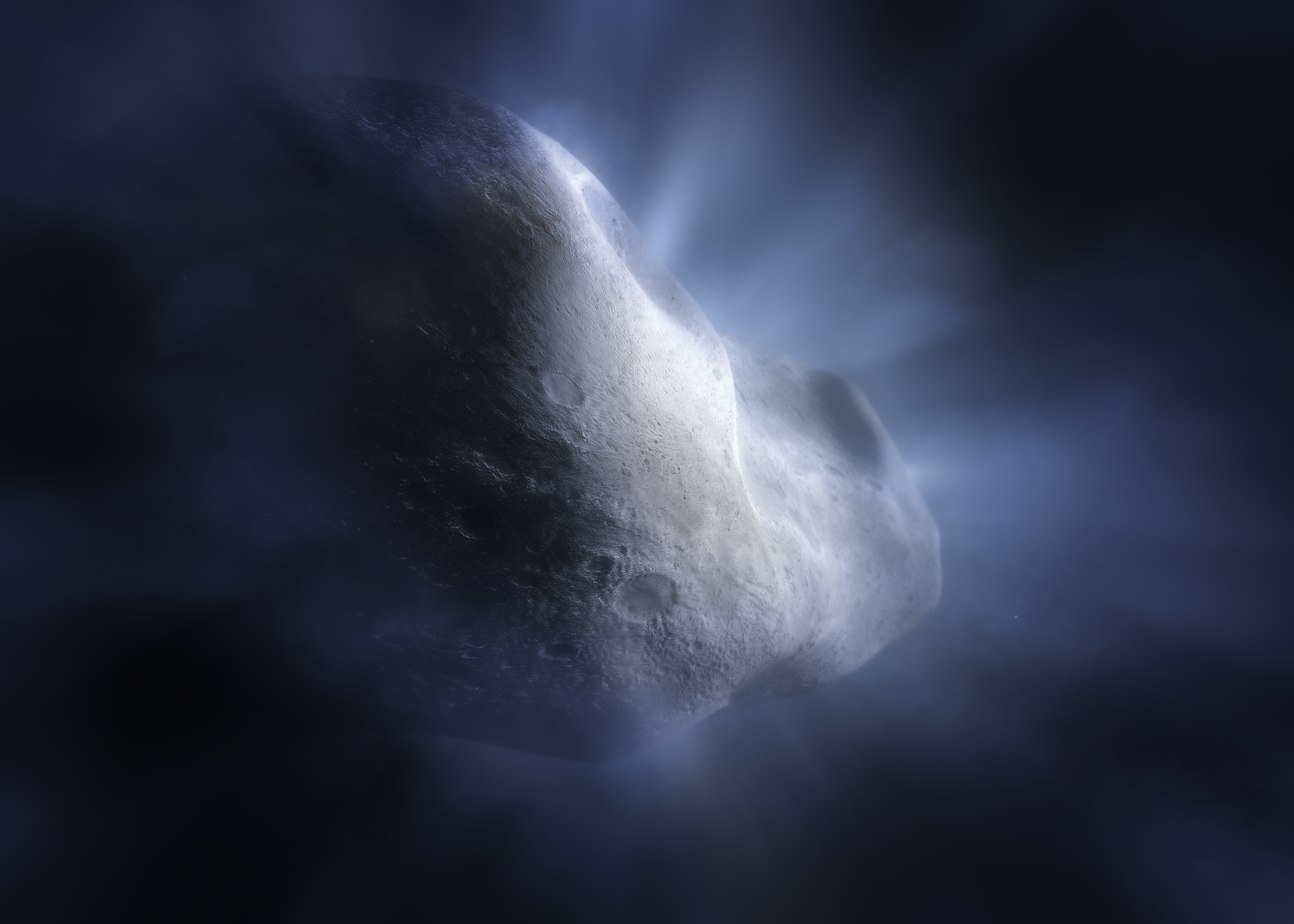1 min read
Comet Spectra Comparison

This graphic presentation of spectral data highlights a key similarity and difference between observations of Comet 238P/Read by the NIRSpec (Near-Infrared Spectrograph) instrument on NASA’s James Webb Space Telescope in 2022 and observations of Comet 103P/Hartley 2 by NASA’s Deep Impact mission in 2010. Both show a distinct peak in the region of the spectrum associated with water. Finding this in Comet Read was a significant accomplishment for Webb, as it is in a different class of comets than Jupiter-family comets like Hartley 2, and this marks the first time that a gas has been confirmed in such a main belt comet.
Though it is only one example, the water detection in Comet Read is evidence that water from the early solar system can be preserved in the asteroid belt, where it is much warmer than the more distant regions where most comets reside.
Comet Read had more in store for scientists, though, when further down the spectrum Comet Read did not show the characteristic, expected bump indicating the presence of carbon dioxide. Comet Hartley 2’s spectrum provides an example of what was anticipated. Carbon dioxide is typically 10 percent of the material in a comet that sublimates near the Sun, producing the characteristic coma and tail of a comet.
Future Webb observations of main belt comets will be necessary to begin understanding whether Comet Read is unique in its lack of carbon dioxide, or if this is a previously-unknown feature of comets in the asteroid belt.
Extended Description and Image Alt Text
Extended Description
Header reads main belt comet 238 P/Read, Emission Spectrum. Subhead at right reads NIRSpec IFU Medium Resolution Spectroscopy.
Graph, vertical axis labeled Brightness with arrow labeled more, pointing up, and less, pointing down. Horizontal axis labeled with numbers about an inch apart, 1-6. Text below numbers reads Wavelength of Light, microns. A hazy blue telescope image of a comet appears in the background of the graph, toward the upper left between 2 and 3 microns.
Color key shows that white line is Comet 238 P/Read, captured by Webb, and blue line is Comet 103 P/Hartley 2, captured by Deep Impact. The two lines appear, blue over white, with many small peaks. The white line of Comet 238 P/Read stretches from the lefthand vertical axis, beyond 1 micron and slightly more than mid-brightness, to about 5 and one-quarter microns, in a general downward trajectory until about 4 microns, when it begins moving upward again in brightness.
The blue line above, showing data from Comet 103 P/Hartley 2, follows much the same trajectory until about midway past 3 microns, where it becomes noticeably brighter than Comet Read. It is also shorter horizontally, beginning after one micron and ending before 5 microns.
Two important peak features are highlighted by a vertical, colored gradient column. A blue column appears roughly between 2.5 and 3 microns, labeled Water H2O, behind a distinct peak in the lines for both comets, showing that water was detected in both. The blue column highlighting this feature overlaps with the tail of the comet image in the background.
Another column, colored with a red gradient, appears between 4 and 4.5 microns and is labeled carbon dioxide CO2. Here the two comets show a distinct difference in their line, with Comet Hartley’s line showing a distinct peak while Comet Read’s line does not.
Text logo reading Webb Space Telescope appears in the lower right corner of the infographic.
Image Alt Text
Graph comparing the spectral data of Comet 238 P/Read and Comet 103 P/Hartley 2, highlighting the detection of water in both, and the absence of carbon dioxide in Comet Read. See extended description for full details.
- Release DateMay 15, 2023
- Science ReleaseNASA’s Webb Finds Water, and a New Mystery, in Rare Main Belt Comet
- CreditIllustration: NASA, ESA, CSA, Joseph Olmsted (STScI)
Related Images & Videos

Artist's Concept of Comet 238P/Read
This illustration of Comet 238P/Read shows the main belt comet sublimating—its water ice vaporizing as its orbit approaches the Sun. This is significant, as the sublimation is what distinguishes comets from asteroids, creating their distinctive tail and hazy halo, or coma. It is...

Comet 238P/Read (NIRCam Image)
This image of Comet 238P/Read was captured by the NIRCam (Near-Infrared Camera) instrument on NASA’s James Webb Space Telescope on September 8, 2022. It displays the hazy halo, called the coma, and tail that are characteristic of comets, as opposed to asteroids. The dusty coma...

Comet 238P/Read (NIRCam Compass Image)
Image of Comet 238P/Read captured by the Webb Telescope’s NIRCam (Near-Infrared Camera), with compass arrows, scale bar, and color key for reference. The north and east compass arrows show the orientation of the image on the sky. Note that the relationship between north and east...
Share
Details
Laura Betz
NASA’s Goddard Space Flight Center
Greenbelt, Maryland
laura.e.betz@nasa.gov
NASA, ESA, CSA, Joseph Olmsted (STScI)






























